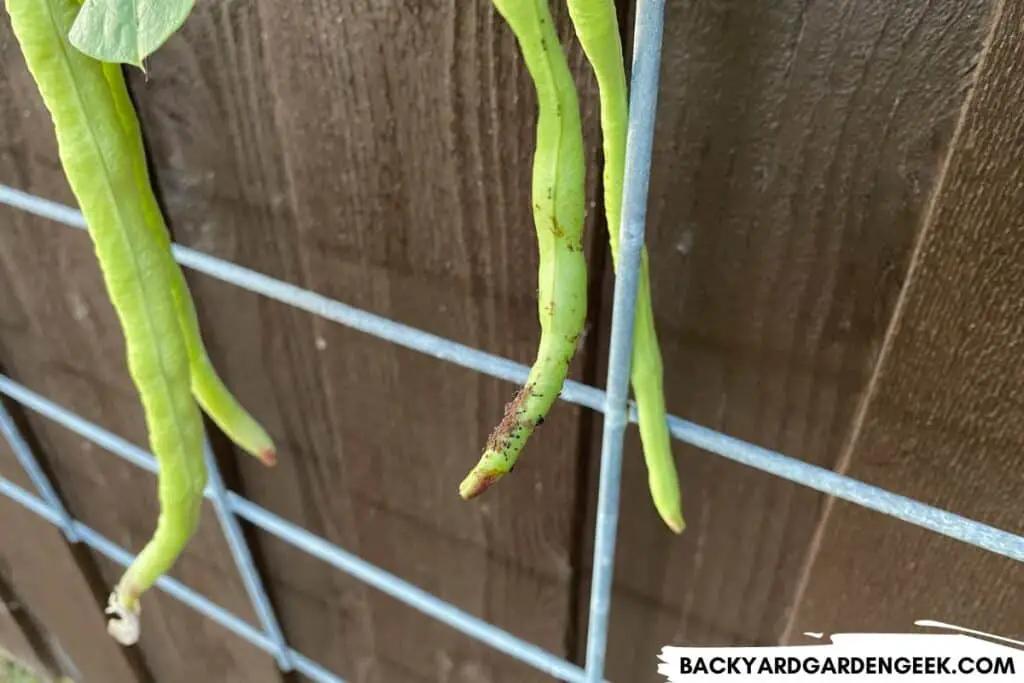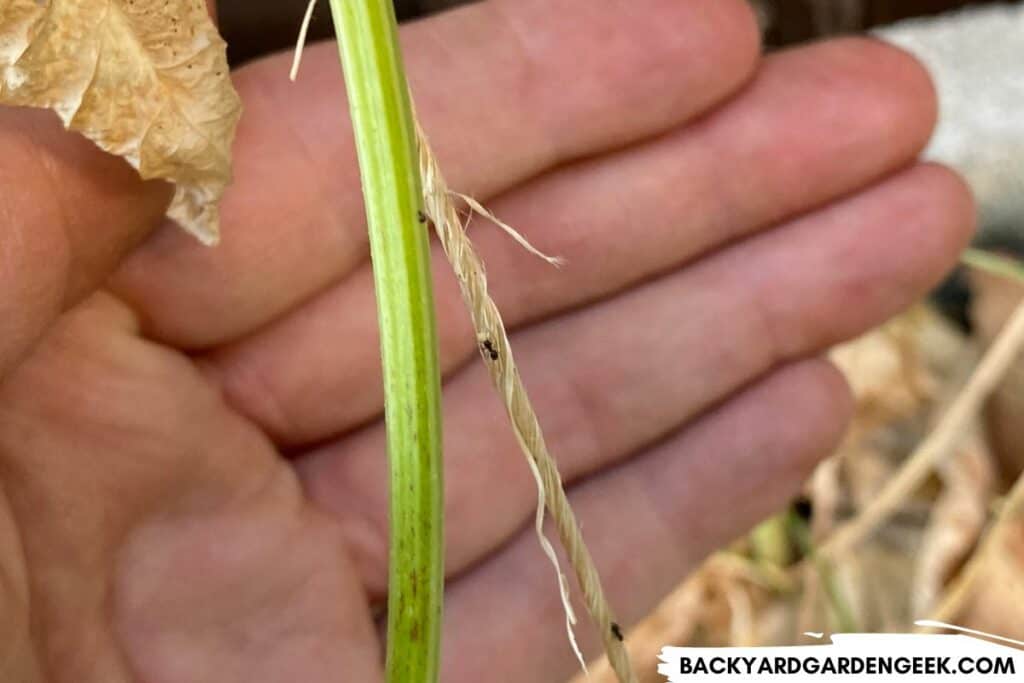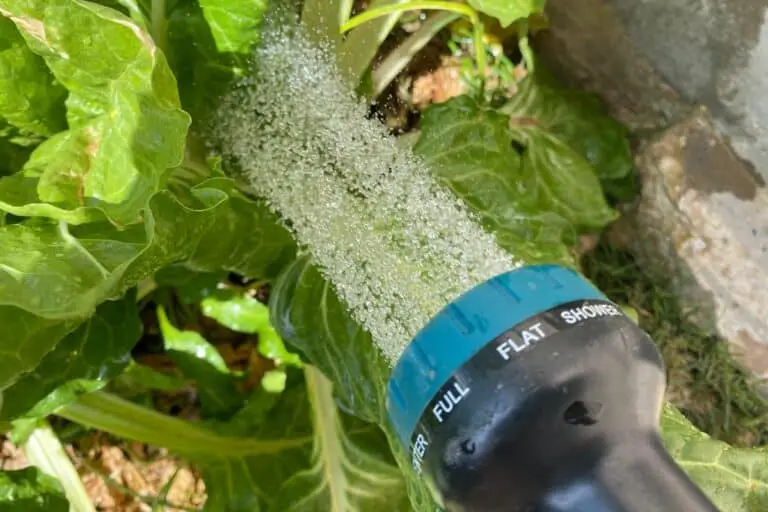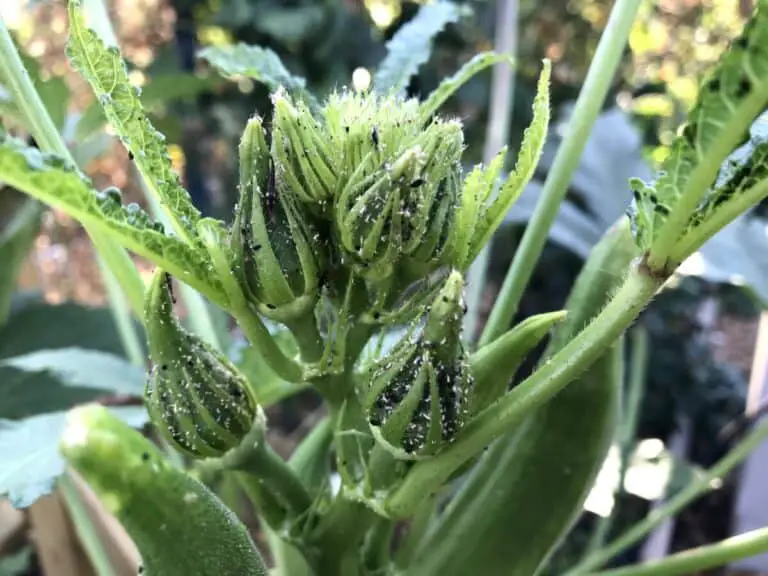Ants on Your Bean Plants? Here’s How to Get Rid of Them
Early one summer morning, I strolled out to the garden with my farm basket looped over my arm, eager to harvest my beans. I had plans for those beans. Some we’d be having for dinner that night, and the rest I’d be freezing.
Imagine my surprise when instead of green I saw lots of black!
I’m used to seeing all kinds of strange happenings in my garden; however, I’d never seen ants building colonies on my pole beans and wasn’t really sure what to do about it at first.
If you’ve ever gone out to check the progress of your beans and see more black than green, you know the panic I felt. Yikes!
Why were all those ants on my plants? And how do I get rid of them quickly?
Ants will gather on bean plants to feed on aphid honeydew or the nectar produced by the plant’s extrafloral nectaries, so the best way to get rid of them is to stop the underlying aphid infestation using soapy water or neem oil or blast the plant with streams of water to dislodge unwanted pests.
In this article, I’ll explain why ants are on your bean plants, and together, we’ll explore:
- the mutually beneficial relationship ants have with aphids (it’s kinda cool despite its destructiveness).
- the fascinating world of extrafloral nectaries and which bean plant varieties have them.
- the 3 steps you can take to naturally get rid of your ants (plus 6 recipes for sprays, baits, and traps that actually work!)
- how ants are both friend and foe in your vegetable garden.

Why Are Ants on My Bean Plants?
There are two possible reasons why ants are visiting your bean plants:
- You have an aphid infestation.
- The extrafloral nectaries of your bean plants are active.
The first reason is that aphids are present.
Ants don’t usually eat bean plants (although leafcutter and stinging fire ants are exceptions). However, ants do love aphids. And aphids are a big problem in the garden.
Therefore, if you see a few ants walking up and down your bean plants, chances are they’re the scouts out looking for aphids because of the honeydew they secrete.
If you’re seeing increased ant activity on your beans, you can be sure that the scouts have found the aphids and that the line of ants you see are following their pheromone trails.
Ants and aphids have a mutually beneficial symbiotic relationship. In exchange for the sweet honeydew byproduct that aphids produce while feeding on plant nutrients, ants protect the aphids from insect predators such as ladybugs, ground beetles, hoverflies, lacewing larvae, and parasitic wasps.
Called a mutualistic relationship, ants and aphids have a long-established partnership that you need to be aware of as a backyard gardener.
The second reason you see ants on your bean plants is that the nectar-producing glands of your plants (called extrafloral nectaries) are active.
Extrafloral nectaries (EFNs) are rarely bigger than 1mm and range in color from yellow and black to green and shades of purple. I’m sure you’ve seen them before and wondered what those sticky little extra leaves, bumps, or small protuberant appendages were.
Simply put, they’re super-rich nectar produced by almost 4,000 different species of plants. And you can find EFNs on any part of your bean plant that’s above ground (i.e. the leaves, stems, petioles, or flower buds).
Like the aphids, the extrafloral nectaries have a mutualistic relationship with the ants. The ants harvest the nectar and protect the plants from harmful insects, such as aphids (whenever they’re not actively “farming” them for their secreted nectar), caterpillars, mealybugs (another insect ants sometimes “farm”), moths, and wasps.

When it comes to bean plants grown in the backyard garden, here’s a list of bean varieties that have EFNs:
- Adzuki
- Broad (fava)
- Bush varieties
- Common (fresh green beans)
- Cowpeas (also called black-eyed peas)
- Garbanzo
- Java
- Lima (butter bean)
- Mung
- Pigeon peas
- Pole varieties
- Runner beans (scarlet and multiflora)
- Snap
- String
How Do I Get Rid of Ants on My Bean Plants?
Here are the three steps I use to get rid of ants on my bean plants:
Step 1: Spray with Water from a Hose
First, I take my garden hose and blast my bean plants with water. It knocks off both the ants and quite a few aphids as well. You won’t kill off all aphids when spraying them with water, but you’ll take care of some of them.
However, water alone won’t remove the pheromone trails the ants leave behind. That usually requires using stronger-smelling sprays to negate the strong pheromones.
Step 2: Spray or Sprinkle with a Prepared Mixture.
Next, I follow up with a natural mixture I spray directly on the plants or sprinkle on the ground. This step obliterates the ant pheromone trails. You can choose from the following:
Option 1. Spray the soil with distilled white vinegar.
Vinegar’s strong smell will deter both a few wandering scouts and a whole colony of ants.
Fill a spray bottle with one part distilled white vinegar to four parts water. Mix and spray on the top of the soil where you see ant activity.
Option 2. Spray liquid soap on the plants.
Soapy liquid makes it hard for ants and aphids to cling to the slippery surfaces.
Mix 1-5 tablespoons (depending on how severe the infestation) of liquid soap with a gallon of water in a spray bottle. Liberally spray the foliage on both sides of the leaves to get rid of aphids. Reapply frequently to eradicate ants.

My favorite liquid soup is Dr. Bronner’s Peppermint Castile Soap, but insecticidal soap and regular organic dish soap are good options too. Just be sure to follow the instructions on the insecticidal soap bottle so that you don’t overdo it.
Options 3. Sprinkle brewed coffee grounds on the soil.
Coffee can provide a natural way to repel ants. Take leftover coffee grounds and sprinkle them wherever you don’t want ants to go. The smell will repel them from your garden. This isn’t a permanent solution, but it sometimes works as a short-term solution while you deal with the aphids among your plants.
Option 4. Sprinkle food grade Diatomaceous Earth on dry soil.
DE is a non-toxic substance that kills ants. Spread a layer on top of the dry soil around your plants wherever you notice ant activity. Reapply after you water or if it rains when the soil has dried out.
Step 3: Put Out Natural Ant Bait or Traps.
Here are my preferred approaches:
Option 1. Borax and Sugar Bait
Mix .5 cups of sugar with 1.5 tablespoons of borax and 1.5 cups of warm water to make ant bait (118 ml + 22 ml + 360 ml for any readers who live outside the United States).
Dip a few cotton balls into the mixture and place them on top of areas where you see a concentration of ants. This is an effective way to kill an entire ant colony.
Since borax can be harmful to humans if ingested and an eye irritant if particles waft upward, wear gloves and protective goggles. Immediately wash your gloves and hands afterward.

Option 2. Borax and Sugar Trap
Using the above recipe, combine the borax, sugar, and warm water in a plastic bottle. Poke holes in the bottle and lay the borax traps in your garden. Very soon, the bottle will fill up with dead ants.
Option 3. Cornmeal and Boric Acid Trap
Mix one part of cornmeal with nine parts of boric acid. Add enough vegetable oil to make a smooth paste. Put the mixture into a plastic bottle, punch holes, and place it wherever you see ant activity.
While cornmeal won’t kill the ants, it will attract them to the bottle, and the boric acid will kill them when they take the cornmeal back to their nests.
Option 4. Borax and Peanut Butter Bait
For more extreme infestations, use the above borax and sugar trap recipe but substitute the sugar with smooth peanut butter.
Although boric acid can be found in nature, it’s highly toxic. Take precautions by wearing gloves, a mask, protective goggles, and a long sleeve shirt so it doesn’t get on your skin. Wash your hands and gloves immediately after.

Will Ants Ruin My Vegetable Garden?
Ants seldom feed directly on plants. But they can damage plants in other ways.
For instance, when ant colonies build their nests under plants, they’ll disturb the roots and deprive the plants of water. In small raised beds or planters, they can even bury young shoots when excavating tunnels by depositing soil on them.
Here’s a list of the common ant species found in the garden and how they’re friend and foe:
| Type | Friend/Foe | Description |
|---|---|---|
| Black Ants | Friend | Black ants aerate the soil and protect plants from harmful insects. |
| Carpenter Ants | Foe | Besides destroying wooded areas, they can rot wooden structures that hold and support your plants and damage trellises, borders, and planters. |
| Leafcutter Ants | Foe | They destroy and eat plant leaves, which can reduce your harvest by damaging the plant’s ability to undertake photosynthesis. |
| Red Fire Ants | Foe | They destroy plants by tunneling through root systems and feeding off young buds and seeds. |
| Yellow Meadow Ants | Friend | They live beneath the soil and convert organic materials into plant-friendly nutrients. |
On a positive note, ants are:
- Tiny soil aerators. In moderation, they can help turn over your soil by tunneling through it.
- Part of your garden’s recycling crew. Ants like to scavenge. They’ll even pick up dead insects and turn them into fertilizer for your soil.
- Your natural defense partners. Ants protect your garden from all kinds of unwanted bugs, interrupting their feeding, egg laying, reproduction, and molting cycles.
But while ants maintain soil health and kill off lots of bad pests, they also encourage the presence of aphids.
Remember that mutually beneficial symbiotic relationship I noted earlier in this article?
Because of the coveted honeydew that aphids secrete, ants happily carry their aphid buddies around, protecting them from beneficial predators. They’ll even move them to other plants!
Check out these articles if you want to know more about the symbiotic relationship between ants and aphids:
- Do Aphids Attract Ants?
- Do Ants Eat or Kill Aphids? 6 Environmental Factors
- Do Ants Make Aphids Worse? 7 Behaviors to Understand
- Why Do Ants Protect Aphids? 7 Things You Should Know

Despite their tendency to protect aphid colonies, ants are much more beneficial to the health of your garden than a nuisance. They’re vital for a balanced garden ecosystem and, understood in a positive light, are also your garden’s early-warning alert sentries for the presence of aphids.
Additional Information
If you’ve enjoyed reading about what to do when you see ants on your plants, take a look at these articles for more information:






